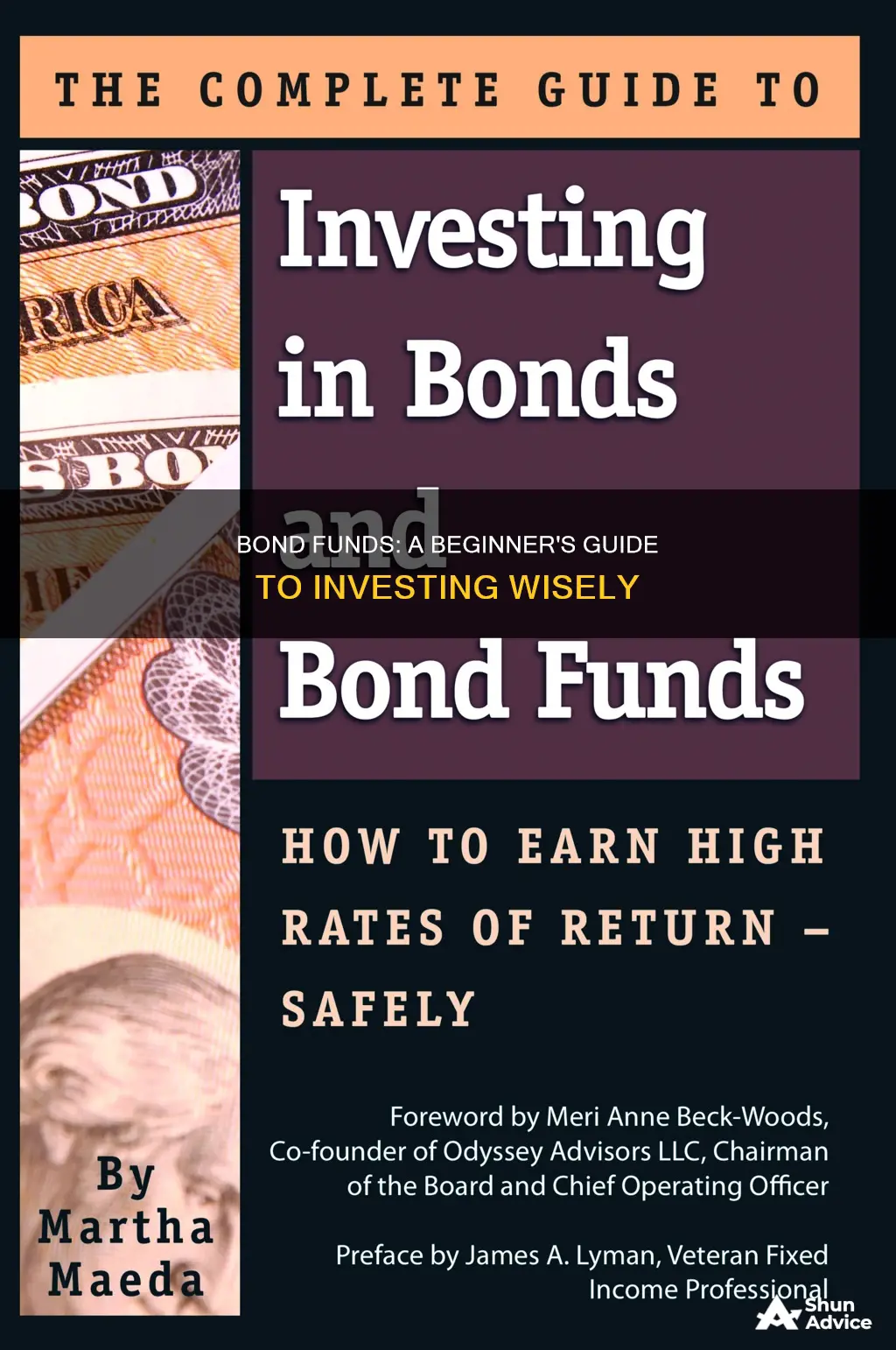
Investing in bonds can be a great way to balance your portfolio and lower risk. Bonds are a way for organisations to raise money by borrowing from investors, who are then paid back with interest over a specified period of time.
There are several types of bonds, including corporate, municipal and treasury bonds. Bonds can be bought individually or as part of a bond fund, which is a mutual fund that invests in a variety of bonds.
There are pros and cons to both buying individual bonds and investing in bond funds. Buying individual bonds gives you more control over your portfolio, but requires more time and financial resources. Bond funds, on the other hand, offer less control but are more diversified and require a lower dollar commitment.
When investing in bonds, it's important to consider factors such as the maturity date, the bond's rating, the issuer's track record, and your own risk tolerance.
| Characteristics | Values |
|---|---|
| Definition | A bond is a loan to a company or government that pays back a fixed rate of return. |
| Interest rate | Bonds have a fixed or floating interest rate. |
| Coupon rate | The coupon rate is the annual percentage of the face value that is paid as interest. |
| Zero-coupon bonds | Zero-coupon bonds pay no interest until maturity. |
| Bond funds | Bond funds are mutual funds that invest in a variety of bonds. |
| Bond types | The three major types of bonds are corporate, municipal, and treasury bonds. |
| Credit rating | The higher the credit rating, the greater the likelihood the company will honour its obligations and the lower the interest rates it will have to pay. |
| Risk | Bonds are considered less risky than stocks. |
| Income generation | Bonds provide a fixed amount of income at regular intervals. |
| Diversification | Bonds can help diversify your portfolio. |
| Capital preservation | Bonds can help protect the absolute value of your investment. |
| Inflation risk | Inflation reduces the purchasing power of your interest payments. |
| Credit risk | There is a possibility that an issuer could default on its debt obligation. |
| Liquidity risk | There is a possibility that an investor might wish to sell a bond but is unable to find a buyer. |
What You'll Learn

Bond funds vs individual bonds
Bond Funds vs. Individual Bonds
There are several factors to consider when deciding between investing in bond funds and individual bonds, including diversification, convenience, costs, and control over maturity. While bond funds are often considered safer, this is not necessarily true if an appropriate bond fund or collection of funds is chosen. Here is a detailed comparison of the two options:
Diversification
Bond funds offer greater diversification per dollar invested, as they provide exposure to a basket of bonds from various issuers, maturity dates, coupon rates, and credit ratings. On the other hand, achieving diversification with individual bonds can be challenging and costly, as they are typically sold in increments of $1,000, requiring a significant amount of bonds to create a diverse portfolio.
Convenience
Bond funds require less time and effort to manage, as they are professionally managed and provide access to institutional pricing. In contrast, investing in individual bonds demands significant research and ongoing monitoring of the financial stability of each issuer and the performance of the bonds.
Costs
Bond funds usually come with management fees, which can lead to higher costs compared to individual bonds, which generally only incur commissions when bought or sold. However, the pricing for individual bonds may be less attractive than what institutional investors receive, and transaction costs can add up with more frequent trades.
Control over Maturity
Individual bonds offer a predictable value at maturity, assuming no default, and provide a reliable income stream for planning. In contrast, bond funds do not guarantee the recovery of the principal at a specific time, especially in a rising-rate environment, and their net asset value (NAV) fluctuates with the market.
Other Considerations
The decision between bond funds and individual bonds depends on various factors, including the amount of money available for investment, financial goals, and behavioural preferences. Individual bonds offer greater control and transparency over the portfolio but require a greater commitment of time and financial resources. Bond funds, on the other hand, provide easier diversification and require less research and oversight but offer less control over the specific investments.
Fidelity Blue Chip Growth Fund: A Smart Investment Strategy
You may want to see also

Pros and cons of bond funds
Bond funds are a great way to get exposure to the bond market and can be a good option for beginners. Here are some pros and cons to help you decide if bond funds are right for you:
Pros of Bond Funds
- Greater diversification: Bond funds provide exposure to a basket of bonds from different issuers, with varying maturity dates, coupon rates, and credit ratings. This diversification is difficult to achieve when investing in individual bonds, as they typically have high denominations and require a large amount of capital to build a diverse portfolio.
- Access to institutional pricing: Bond funds benefit from economies of scale and tend to receive better pricing on individual bonds compared to what an individual investor would get. Lower prices mean higher yields for the investor.
- Professional management: The fixed-income market, especially riskier segments like high-yield bonds, bank loans, or preferred securities, requires a good understanding of industry trends and credit analysis. Bond funds offer professional management that can actively buy or sell bonds depending on the economic and interest rate environment, potentially increasing returns and income.
Cons of Bond Funds
- Management fees: Actively managed bond funds tend to have higher management fees, which may lead to lower returns for the investor. In contrast, individual bonds usually have a commission charged only when the bond is bought or sold, with no other ongoing fees.
- Net asset value (NAV) fluctuations: The NAV of a bond fund will fluctuate with interest rates—as interest rates rise, the NAV falls, and vice versa. This makes bond funds less attractive than individual bonds for those planning for future liabilities or those who want a predictable value at maturity.
- Different cost basis and tax consequences: With bond funds, your cost basis for tax purposes is based on the pooled funds used to purchase the bonds and is more complex than that of individual bonds. Additionally, the buying and selling of individual bonds within the fund may lead to capital gain distributions at the end of the year, making tax planning more challenging.
When deciding whether to invest in individual bonds or bond funds, it's essential to consider your investment goals, time horizon, risk tolerance, and behavioural preferences. Individual bonds offer a predictable income stream and a predictable value at maturity, while bond funds provide greater diversification and professional management but come with management fees and NAV fluctuations.
Index Funds: When to Start Investing for Maximum Returns
You may want to see also

Pros and cons of individual bonds
Pros of Individual Bonds:
- Greater control and transparency: When you buy individual bonds, you have total control over what you own (within the limits of what's available in the marketplace and your budget). You choose what you buy and whether to hold those bonds until maturity or sell them beforehand. You may also be able to better plan and control your income stream since you'll know the maturity dates and coupon payment dates of the bonds you own.
- Predictable income: Bonds provide fixed income payments, offering a predictable and steady stream of income. Most bonds make coupon payments twice a year, though the exact dates may vary. This predictability can be appealing to investors who need the money for day-to-day expenses or those seeking to construct a portfolio of bonds that make equal coupon payments each month.
- Safety: Bonds are considered relatively safe and stable investments. US Treasury bonds, for example, are backed by the full faith and credit of the US government. While there is a risk of default, it is uncommon.
- Lower risk than stocks: Bonds tend to be less risky than stocks or equity funds. Even if a company files for bankruptcy, bondholders often receive some of their investment back, whereas shareholders could lose everything.
- Relatively high returns: Bonds can offer higher yields than savings accounts and some certificates of deposit (CDs) with similar maturity dates.
- No ongoing management fees: Individual bonds generally don't entail ongoing management fees, and if you simply buy and hold a portfolio of bonds until maturity, your total costs could be quite low.
Cons of Individual Bonds:
- High minimum investment: Investing in individual bonds typically requires a higher initial investment amount compared to bond funds. Bonds usually trade with a minimum order quantity, which may be as low as $1,000 or as high as $100,000 or more. Diversifying a bond portfolio can be challenging and expensive.
- Values drop when interest rates rise: If interest rates increase, the value of your bond will drop since new bonds will be issued with higher interest rates, making your bond less desirable.
- Yields might not keep up with inflation: Over time, the compounding effect of inflation on prices can be significant, reducing the purchasing power of the fixed income you receive from the bond.
- Some bonds can be called early: Many bonds are callable or redeemable, meaning the issuer can repay the bond early. This can disrupt your income stream, and you may not be able to find an equally safe way to earn the same amount of interest.
- Limited liquidity: If you need to access your principal before a bond matures, you can sell it, but this may entail transaction fees. Certain bond types, such as Treasuries and some corporate bonds, are easier to sell than most municipal bonds, which trade in thinner and less liquid markets.
Vanguard Windsor II: Uncovering its Security Strategy
You may want to see also

How to buy bond funds
Bond funds are a great way to get exposure to the bond market and can be purchased through most major brokerages.
A bond fund is a mutual fund or exchange-traded fund (ETF) that exclusively holds bonds in its portfolio. These funds are convenient as they are usually low-cost and contain a broad base of diversified bonds, so you don't need to do your research to identify specific issues.
- Decide on the type of bond fund: There are different types of bond funds, such as corporate, municipal, and government bond funds. Each has its own risk and return profile, so be sure to understand the differences before investing.
- Choose a brokerage platform: You can buy bond funds through an online brokerage platform. Compare different platforms to find one that offers the types of bond funds you want to invest in and has low fees.
- Open an account: Once you've chosen a brokerage platform, open an account by providing the necessary information, such as your personal and financial details.
- Fund your account: You will need to deposit money into your brokerage account to purchase the bond funds. The minimum investment amount will vary depending on the fund and brokerage platform.
- Purchase the bond funds: Use the funds in your brokerage account to purchase the bond funds you have chosen. Be sure to review the fund's prospectus and understand the fees, risks, and potential returns before investing.
- Monitor and manage your investment: Once you've purchased the bond funds, be sure to monitor their performance over time. You may also need to periodically rebalance your portfolio to maintain your desired asset allocation.
Keep in mind that buying and holding bonds until maturity is a common investment strategy. Another strategy is to sell the bonds early to try to make a profit. Additionally, it is important to check a bond's rating before investing to learn about its financial health.
Bond Index Funds: A Smart, Diversified Investment Strategy
You may want to see also

How to buy individual bonds
Individual bonds can be purchased either in primary markets, where the bond is purchased from the issuer, or secondary markets, where the bond is purchased from the previous holder.
Buying Individual Bonds from the Primary Market
The primary market can be difficult to access for all but the wealthiest investors. However, you may be able to receive a discount off an individual bond's face value by buying it directly from the underwriting investment bank in an initial bond offering.
Buying Individual Bonds from the Secondary Market
Bondholders often sell their bonds before maturity on a secondary market, where pricing is less transparent. It can be difficult to know the true cost of individual bonds on the secondary market, as prices frequently include markups. You may also be charged commissions, transaction fees, and contract fees on your bond-related transactions.
If you're buying municipal bonds, you can research fair pricing using the Electronic Municipal Market Access (EMMA) website. For corporate bonds, you'll need to perform a price comparison to ensure you're comfortable with the spread a broker is charging.
Treasury bonds are not offered on the secondary market by the government but can be purchased via brokerages.
Buying Individual Bonds from the U.S. Government
Investors can buy Treasury bonds directly from the U.S. government at TreasuryDirect. These are available in 20- or 30-year terms and pay a set interest rate every six months. No fees or commissions are charged, but you must have a Social Security number, a U.S. address, and a U.S. bank account.
Buying Individual Bonds from the U.K. Government
In the U.K., government bonds are called "gilts". These can be bought directly from the U.K. Debt Management Office's purchase and sale service or on the secondary market, which is accessible via brokers and banks.
Buying Individual Corporate Bonds
The easiest way to buy corporate bonds is on the secondary market through an online broker. Most brokers offer a wide selection and will typically list the coupon, the day the loan is due to be paid back, and the price.
Strategies for Buying Individual Bonds
A bond ladder is a strategy that attempts to minimise the risks associated with fixed-income securities while managing cash flows for the individual investor. In a bond ladder, the bonds' maturity dates are evenly spaced so that the proceeds are reinvested at regular intervals as the bonds mature. By staggering maturity dates, you won't be locked into one bond for a long duration.
A Beginner's Guide to Investing in Vanguard Funds
You may want to see also
Frequently asked questions
Bond funds are a type of investment fund that pools money from multiple investors to purchase a variety of individual bonds. These bonds are typically bought and managed by a fund manager. Bond funds offer a way to invest in bonds with a lower dollar commitment and provide immediate diversification.
Bond funds offer several advantages over investing in individual bonds. They provide broad diversification with a lower financial commitment, making them more accessible to small investors. They also require less research and oversight, as you don't need to research individual bonds or issuers. Additionally, bond funds are managed by professionals, so you don't need to have expertise in bond investing.
While bond funds offer diversification and professional management, there are some risks to consider. Bond funds typically include higher management fees and commissions, and the income generated can fluctuate as they invest in multiple bond types. There may also be redemption fees if you sell your shares within a certain period (e.g., 60 to 90 days). Additionally, leveraged bond funds carry greater risk.
When choosing a bond fund, consider factors such as your risk tolerance, investment objectives, and time horizon. Compare the fees and expenses associated with different funds, as higher expense ratios can reduce your overall returns. Also, pay attention to the underlying benchmark the fund uses and its tracking error.
You can invest in bond funds through most major brokerages. You can open an account with a brokerage firm and choose from a variety of bond mutual funds or exchange-traded funds (ETFs) that align with your investment goals and risk tolerance. Remember to consider the fees and expenses associated with each fund before investing.







